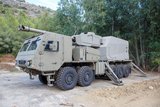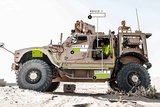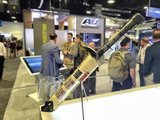Teledyne FLIR introduces Rogue 1 recoverable loitering munition system
Rogue 1 is an entirely new system from the ground up according to the manufacturer. (Photo: Teledyne FLIR Defense)
Teledyne FLIR Defense has unveiled its next generation of loitering munition with recoverable capabilities at SOF Week 2024 in Tampa. Rogue 1 is a small UAS designed to provide versatility and survivability, and to be remotely disarmed, safely recovered and reused when targets are disengaged or missions are aborted.
Speaking to Shephard, Brian Bills, director of UAS products within Teledyne FLIR, claimed that it 'is an entirely new system from the ground up'.
Rogue 1 features a vertical take-off and landing architecture, enabling it to target enemy forces in congested areas. It is engineered to use three different payloads:
Already have an account? Log in
Want to keep reading this article?
More from SOF Week 2024
-
![US companies implement diverse strategies to enhance supply chain]()
US companies implement diverse strategies to enhance supply chain
The conflicts in Ukraine and Israel have been driving the US defence industry toward increasing production of platforms and systems.
-
![How propulsion technology can improve vessel performance]()
How propulsion technology can improve vessel performance
Next-generation propellers have been designed to enhance range and speed while reducing fuel consumption.
-
![Galvion introduces BATLCHRG for seamless wireless charging in special operations]()
Galvion introduces BATLCHRG for seamless wireless charging in special operations
Galvion unveiled the BATLCHARG wireless charging system at SOF Week, designed for special operations forces to recharge gear on the move or while stationary, enhancing battlefield power management efficiency.
-
![Booz Allen unveils AR real-time language translation tool]()
Booz Allen unveils AR real-time language translation tool
The Augmented Reality Translate solution enables operators in the field to read foreign language signs and have them translated in an augmented reality headset.
-
![Spectra Group showcases the GENSS tactical radio at SOF Week, enhancing global special operations communications]()
Spectra Group showcases the GENSS tactical radio at SOF Week, enhancing global special operations communications
Spectra Group introduced the GENSS tactical radio at SOF Week, designed to enhance global special operations with versatile, secure communication across multiple bands and satellite connectivity.
-
![AeroVironment to “dramatically” increase production of Switchblades]()
AeroVironment to “dramatically” increase production of Switchblades
The company plans to double or triple production rates for Switchblade 600 and 300 systems.

























